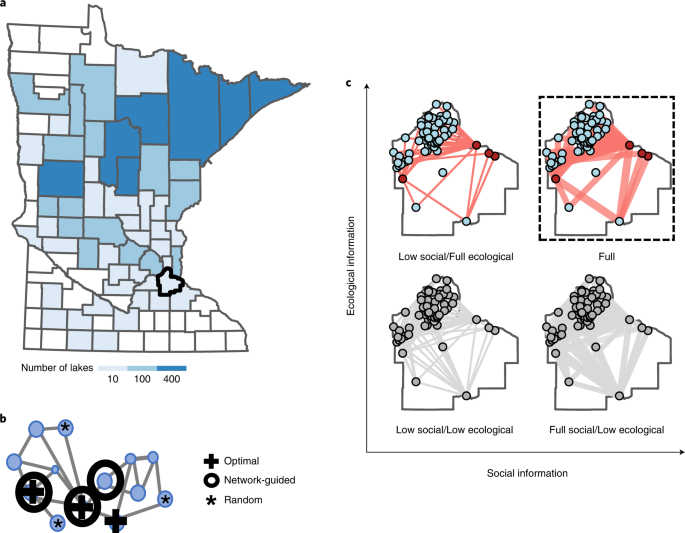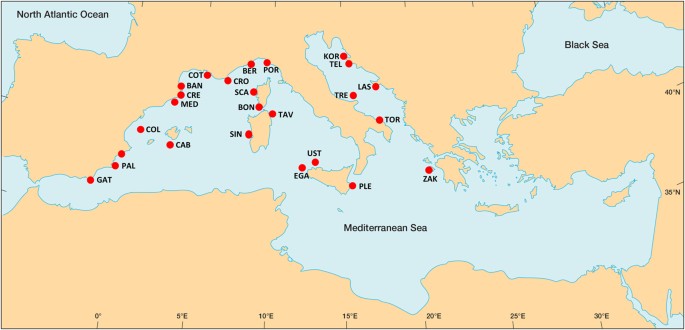
- Select a language for the TTS:
- UK English Female
- UK English Male
- US English Female
- US English Male
- Australian Female
- Australian Male
- Language selected: (auto detect) - EN
Play all audios:
ABSTRACT Complex socio-environmental interdependencies drive biological invasions, causing damages across large spatial scales. For widespread invasions, targeting of management activities
based on optimization approaches may fail due to computational or data constraints. Here, we evaluate an alternative approach that embraces complexity by representing the invasion as a
network and using network structure to inform management locations. We compare optimal versus network-guided invasive species management at a landscape-scale, considering siting of boat
decontamination stations targeting 1.6 million boater movements among 9,182 lakes in Minnesota, United States. Studying performance for 58 counties, we find that when full information is
known on invasion status and boater movements, the best-performing network-guided metric achieves a median and lower-quartile performance of 100% of optimal. We also find that performance
remains relatively high using different network metrics or with less information (median >80% and lower quartile >60% of optimal for most metrics) but is more variable, particularly at
the lower quartile. Additionally, performance is generally stable across counties with varying lake counts, suggesting viability for large-scale invasion management. Our results suggest
that network approaches hold promise to support sustainable resource management in contexts where modelling capacity and/or data availability are limited. Access through your institution Buy
or subscribe This is a preview of subscription content, access via your institution ACCESS OPTIONS Access through your institution Access Nature and 54 other Nature Portfolio journals Get
Nature+, our best-value online-access subscription $32.99 / 30 days cancel any time Learn more Subscribe to this journal Receive 12 digital issues and online access to articles $119.00 per
year only $9.92 per issue Learn more Buy this article * Purchase on SpringerLink * Instant access to full article PDF Buy now Prices may be subject to local taxes which are calculated during
checkout ADDITIONAL ACCESS OPTIONS: * Log in * Learn about institutional subscriptions * Read our FAQs * Contact customer support SIMILAR CONTENT BEING VIEWED BY OTHERS PROTECTED AREA
NETWORKS DO NOT REPRESENT UNSEEN BIODIVERSITY Article Open access 10 June 2021 INVACOST, A PUBLIC DATABASE OF THE ECONOMIC COSTS OF BIOLOGICAL INVASIONS WORLDWIDE Article Open access 08
September 2020 MIXED EFFECTS OF A NATIONAL PROTECTED AREA NETWORK ON TERRESTRIAL AND FRESHWATER BIODIVERSITY Article Open access 13 September 2023 DATA AVAILABILITY The network data used in
this study were previously reported37 and are available at https://conservancy.umn.edu/handle/11299/216936. The minimal dataset supporting this study, including network data, lake metadata
including infestation status and geospatial data delineating county boundaries are available50. CODE AVAILABILITY Analysis used R v.4.0.2 (2020-06-22) using packages dplyr (v.1.0.7), purrr
(v.0.3.4), ggplot2 (v.3.3.3), igraph (v.1.2.5), quantreg (v.5.61) and Rglpk (v.0.6-4). Full analysis code underlying all analyses are available50. REFERENCES * Banks, N. C., Paini, D. R.,
Bayliss, K. L. & Hodda, M. The role of global trade and transport network topology in the human-mediated dispersal of alien species. _Ecol. Lett._ 18, 188–199 (2015). Article Google
Scholar * Epanchin-Niell, R. et al. Controlling invasive species in complex social landscapes. _Front. Ecol. Environ._ 8, 210–216 (2009). Article Google Scholar * Charles, H. & Dukes,
J. S. in _Biological Invasions_ (ed. Nentwig, W.) 217–237 (Springer, 2007). https://doi.org/10.1007/978-3-540-36920-2_13 * Gallardo, B., Clavero, M., Sánchez, M. & Vilà, M. Global
ecological impacts of invasive species in aquatic ecosystems. _Glob. Change Biol._ 22, 151–163 (2016). Article Google Scholar * Diagne, C. et al. High and rising economic costs of
biological invasions worldwide. _Nature_ 592, 571–576 (2021). Article CAS Google Scholar * Sardain, A., Sardain, E. & Leung, B. Global forecasts of shipping traffic and biological
invasions to 2050. _Nat. Sustain._ 2, 274–282 (2019). Article Google Scholar * Epanchin-Niell, R. S. & Hastings, A. Controlling established invaders: integrating economics and spread
dynamics to determine optimal management. _Ecol. Lett._ 13, 528–541 (2010). Article Google Scholar * Chades, I. et al. General rules for managing and surveying networks of pests, diseases,
and endangered species. _Proc. Natl. Acad. Sci. USA_ 108, 8323–8328 (2011). Article CAS Google Scholar * Epanchin-Niell, R. S. & Wilen, J. E. Optimal spatial control of biological
invasions. _J. Environ. Econ. Manag._ 63, 260–270 (2012). Article Google Scholar * Epanchin-Niell, R. S. & Wilen, J. E. Individual and cooperative management of invasive species in
human-mediated landscapes. _Am. J. Agric. Econ._ 97, 180–198 (2015). Article Google Scholar * Aadland, D., Sims, C. & Finnoff, D. Spatial dynamics of optimal management in bioeconomic
systems. _Comput. Econ._ 45, 545–577 (2015). Article Google Scholar * Baker, C. M. Target the source: optimal spatiotemporal resource allocation for invasive species control. _Conserv.
Lett._ 10, 41–48 (2017). Article Google Scholar * Bushaj, S., Büyüktahtakın, İ. E., Yemshanov, D. & Haight, R. G. Optimizing surveillance and management of emerald ash borer in urban
environments. _Nat. Res. Model._ 34, e12267 (2021). Article Google Scholar * Fischer, S. M., Beck, M., Herborg, L.-M. & Lewis, M. A. Managing aquatic invasions: optimal locations and
operating times for watercraft inspection stations. _J. Environ. Manag._ 283, 111923 (2021). Article Google Scholar * Büyüktahtakın, İ. E. & Haight, R. G. A review of operations
research models in invasive species management: state of the art, challenges, and future directions. _Ann. Oper. Res._ 271, 357–403 (2018). Article Google Scholar * Epanchin-Niell, R. S.
Economics of invasive species policy and management. _Biol. Invasions_ 19, 3333–3354 (2017). Article Google Scholar * Bodin, Ö. et al. Improving network approaches to the study of complex
social–ecological interdependencies. _Nat. Sustain._ 2, 551–559 (2019). Article CAS Google Scholar * Nowzari, C., Precaido, V. M. & Pappas, G. J. Analysis and control of epidemics: a
survey of spreading processes on complex networks. _IEEE Control Syst._ 36, 26–46 (2016). Google Scholar * Newman, M. E. J. Spread of epidemic disease on networks. _Phys. Rev. E_ 66, 016128
(2002). Article CAS Google Scholar * Kempe, D., Kleinberg, J. & Tardos, E. Maximizing the spread of influence through a social network. In _Proc. 9th ACM SIGKDD International
Conference on Knowledge Discovery and Data Mining_ 137–146 (ACM Press, 2003). * Pastor-Satorras, R. & Vespignani, A. Immunization of complex networks. _Phys. Rev. E_ 65, 036104 (2002).
Article CAS Google Scholar * Pastor-Satorras, R., Castellano, C., Van Mieghem, P. & Vespignani, A. Epidemic processes in complex networks. _Rev. Mod. Phys._ 87, 925–979 (2015).
Article Google Scholar * Holme, P., Kim, B. J., Yoon, C. N. & Han, S. K. Attack vulnerability of complex networks. _Phys. Rev. E_ 65, 056109 (2002). Article CAS Google Scholar *
Muirhead, J. R. & Macisaac, H. J. Development of inland lakes as hubs in an invasion network. _J. Appl. Ecol._ 42, 80–90 (2005). Article Google Scholar * de la Fuente, B., Saura, S.
& Beck, P. S. Predicting the spread of an invasive tree pest: the pine wood nematode in southern europe. _J. Appl. Ecol._ 55, 2374–2385 (2018). Article Google Scholar * Minor, E. S.
& Urban, D. L. A graph-theory framework for evaluating landscape connectivity and conservation planning. _Conserv. Biol._ 22, 297–307 (2008). Article Google Scholar * Morel-Journel,
T., Assa, C. R., Mailleret, L. & Vercken, E. Its all about connections: hubs and invasion in habitat networks. _Ecol. Lett._ 22, 313–321 (2019). Google Scholar * Perry, G. L. W.,
Moloney, K. A. & Etherington, T. R. Using network connectivity to prioritise sites for the control of invasive species. _J. Appl. Ecol._ 54, 1238–1250 (2017). Article Google Scholar *
Kvistad, J. T., Chadderton, W. L. & Bossenbroek, J. M. Network centrality as a potential method for prioritizing ports for aquatic invasive species surveillance and response in the
Laurentian Great Lakes. _Manag. Biol. Invasions_ 10, 403 (2019). Article Google Scholar * Haight, R. G., Kinsley, A. C., Kao, S.-Y., Yemshanov, D. & Phelps, N. B. Optimizing the
location of watercraft inspection stations to slow the spread of aquatic invasive species. _Biol. Invasions_ 23, 3907–3919 (2021). Article Google Scholar * McEachran, M. C. et al. Stable
isotopes indicate that zebra mussels (_Dreissena polymorpha_) increase dependence of lake food webs on littoral energy sources. _Freshw, Biol._ 64, 183–196 (2019). Article CAS Google
Scholar * Karatayev, A. Y., Burlakova, L. E. & Padilla, D. K. in _Invasive Aquatic Species of Europe. Distribution, Impacts and Management_ (eds Leppäkoski, E. et al.) 433–446
(Springer, 2002). * Prescott, T. H., Claudi, R. & Prescott, K. L. Impact of Dreissenid mussels on the infrastructure of dams and hydroelectric power plants. In _Quagga and Zebra Mussels_
(eds Nalepa, T. F. & Schloesser, D. W.) 243–258 (CRC Press, 2013). * _Invasive Species of Aquatic Plants and Wild Animals in Minnesota: Annual Report for 2020_ (Minnesota Department of
Natural Resources, 2020). * Kanankege, K. S., Alkhamis, M. A., Phelps, N. B. & Perez, A. M. A probability co-kriging model to account for reporting bias and recognize areas at high risk
for zebra mussels and eurasian watermilfoil invasions in Minnesota. _Front. Vet. Sci._ 4, 231 (2018). Article Google Scholar * Mallez, S. & McCartney, M. Dispersal mechanisms for zebra
mussels: population genetics supports clustered invasions over spread from hub lakes in Minnesota. _Biol. Invasions_ 20, 2461–2484 (2018). Article Google Scholar * Kao, S.-Y. Z. et al.
Network connectivity of Minnesota waterbodies and implications for aquatic invasive species prevention. _Biol. Invasions_ 23, 3231–3242 (2021). Article Google Scholar * Kleinberg, J. M.
Authoritative sources in a hyperlinked environment. In _Proc. 9th Annual ACM-SIAM Symposium on Discrete Algorithms_ 668–677 (1998). * McDonald-Madden, E. et al. Using food-web theory to
conserve ecosystems. _Nat. Commun._ 7, 10245 (2016). Article CAS Google Scholar * Bossenbroek, J. M., Kraft, C. E. & Nekola, J. C. Prediction of long-distance dispersal using gravity
models: zebra mussel invasion of inland lakes. _Ecol. Appl._ 11, 1778–1788 (2001). Article Google Scholar * Leung, B., Bossenbroek, J. M. & Lodge, D. M. Boats, pathways, and aquatic
biological invasions: estimating dispersal potential with gravity models. _Biol. Invasions_ 8, 241–254 (2006). Article Google Scholar * Beger, M. et al. Integrating regional conservation
priorities for multiple objectives into national policy. _Nat. Commun_. 6, 8208 (2015). * Runting, R. K. et al. Larger gains from improved management over sparing–sharing for tropical
forests. _Nat. Sustain._ 2, 53–61 (2019). Article Google Scholar * Kinsley, A. C. et al. AIS Explorer: prioritization for watercraft inspections. A decision-support tool for aquatic
invasive species management. _J. Environ. Manage._ 314, 115037 (2022). Article Google Scholar * Vander Zanden, M. J. & Olden, J. D. A management framework for preventing the secondary
spread of aquatic invasive species. _Can. J. Fish. Aquat. Sci._ 65, 1512–1522 (2008). Article Google Scholar * Kanankege, K. S. et al. Lessons learned from the stakeholder engagement in
research: application of spatial analytical tools in one health problems. _Front. Vet. Sci._ 7, 254 (2020). Article Google Scholar * Kroetz, K. & Sanchirico, J. The bioeconomics of
spatial-dynamic systems in natural resource management. _Annu. Rev. Resour. Econ._ 7, 189–207 (2015). Article Google Scholar * Cade, B. S. & Noon, B. R. A gentle introduction to
quantile regression for ecologists. _Front. Ecol. Environ._ 1, 412–420 (2003). Article Google Scholar * Koenker, R. in _Asymptotic Statistics_ (eds Mandl, P. & Hušková, M.) 349–359
(Springer, 1994). * Ashander, J. Analysis code and data for ‘Guiding large-scale management of invasive species using network metrics’. _figshare_
https://doi.org/10.6084/m9.figshare.14402447 (2021). Download references ACKNOWLEDGEMENTS We thank A. Kinsley for comments on a previous draft. Funding for this research was provided by
Resources for the Future and the National Socio-Environmental Synthesis Center (SESYNC) under funding received from the National Science Foundation (NSF) DBI-1639145. The Northern Research
Station, USDA Forest Service also provided support. L.E.D. acknowledges support from NSF OCE-2049360. AUTHOR INFORMATION Author notes * Jaime Ashander Present address: Eastern Ecological
Science Center, Patuxent Research Refuge (Formerly the Patuxent Wildlife Research Center), US Geological Survey, Laurel, MD, USA AUTHORS AND AFFILIATIONS * Resources for the Future,
Washington, DC, USA Jaime Ashander, Kailin Kroetz & Rebecca Epanchin-Niell * School of Sustainability, Arizona State University, Tempe, AZ, USA Kailin Kroetz * Department of Agricultural
and Resources Economics, University of Maryland, College Park, MD, USA Rebecca Epanchin-Niell * Department of Fisheries, Wildlife, and Conservation Biology, College of Food, Agricultural,
and Natural Resource Sciences, University of Minnesota, St Paul, MN, USA Nicholas B. D. Phelps * Northern Research Station, USDA Forest Service, St Paul, MN, USA Robert G. Haight *
Department of Ecology and Evolutionary Biology, University of Colorado, Boulder, CO, USA Laura E. Dee Authors * Jaime Ashander View author publications You can also search for this author
inPubMed Google Scholar * Kailin Kroetz View author publications You can also search for this author inPubMed Google Scholar * Rebecca Epanchin-Niell View author publications You can also
search for this author inPubMed Google Scholar * Nicholas B. D. Phelps View author publications You can also search for this author inPubMed Google Scholar * Robert G. Haight View author
publications You can also search for this author inPubMed Google Scholar * Laura E. Dee View author publications You can also search for this author inPubMed Google Scholar CONTRIBUTIONS
J.A., L.E.D. and K.K. conceived the study. J.A., L.E.D., R.E.-N. and K.K. designed the research. N.B.D.P. and R.G.H. contributed data or analytic tools. J.A. performed the research. J.A.,
L.E.D., R.E.-N. and K.K. wrote the paper and all authors edited the paper. CORRESPONDING AUTHOR Correspondence to Jaime Ashander. ETHICS DECLARATIONS COMPETING INTERESTS The authors declare
no competing interests. PEER REVIEW PEER REVIEW INFORMATION _Nature Sustainability_ thanks Jonathan Bossenbroek and the other, anonymous, reviewer(s) for their contribution to the peer
review of this work. ADDITIONAL INFORMATION PUBLISHER’S NOTE Springer Nature remains neutral with regard to jurisdictional claims in published maps and institutional affiliations.
SUPPLEMENTARY INFORMATION SUPPLEMENTARY INFORMATION Supplementary Sections 1–8, Algorithms 1 and 2, Figs. 1–7, Tables 1–5 and References. REPORTING SUMMARY RIGHTS AND PERMISSIONS Reprints
and permissions ABOUT THIS ARTICLE CITE THIS ARTICLE Ashander, J., Kroetz, K., Epanchin-Niell, R. _et al._ Guiding large-scale management of invasive species using network metrics. _Nat
Sustain_ 5, 762–769 (2022). https://doi.org/10.1038/s41893-022-00913-9 Download citation * Received: 30 July 2021 * Accepted: 06 May 2022 * Published: 14 July 2022 * Issue Date: September
2022 * DOI: https://doi.org/10.1038/s41893-022-00913-9 SHARE THIS ARTICLE Anyone you share the following link with will be able to read this content: Get shareable link Sorry, a shareable
link is not currently available for this article. Copy to clipboard Provided by the Springer Nature SharedIt content-sharing initiative






